Performance Analysis and Monitoring of Vanadium Redox Flow Battery via Polarization curves
Abstract
:1. Introduction
2. Materials and Methods
2.1. Installation of VRFB Single Cell
2.2. Electrolyte Solution Preparation
2.3. V(II) and V(V) Electrolyte Preparation Via Electrochemical Processes and VRFB Performance Tests
3. Results
3.1. The Interaction of Electrolyte Preparation and Discharging Performance
3.2. Flow Rate’s Influence on Discharging Performance
3.3. Observation of Applying Carbon Paper as Electrodes in VRFB
3.4. The Influence of Different Nafion Membrane Specifications on VRFB Performance
4. Conclusions
- (1)
- The highest charging performance was obtained when 1.7 V of charging voltage was imposed. Because the optimal charging voltage must overcome the standard cell potential and activation loss, this electrical potential has a significant impact on the electrochemical reactions generated during the electrolytic process. Furthermore, overpotential can cause side reactions and impurities, which can reduce charging efficiency.
- (2)
- The VRFB, operated using electrolytes prepared by 1.7 V of charging voltages, offered the lowest ohmic loss and concentration losses. Moreover, the completion of the electrochemical reaction during initial charging directly impacts the concentration of species in the catholyte and anolyte, and it brings about the enhancement of maximum power and voltage efficiency.
- (3)
- Even though the VRFB operated using 30 mL/min of electrolyte flow rate had the best performance, with a maximum power and voltage efficiency, 10 mL/min of the flow rate was preferred for application to the VRFB operation. Choosing the appropriate flow rate to achieve the desired performance corresponds to striking a balance between VRFB performance and pump energy efficiency.
- (4)
- The feasibility of using a carbon paper electrode for a flow-through design was investigated in terms of the number of electrode layers as well as electrolyte flow and diffusion behavior in flow channels and electrode layers. A ten-layer electrode is anticipated to offer a highly active area, but results indicate that using many layers of an electrode may reduce the porosity of the electrode, resulting in a reduction in the active area. This phenomenon causes an increase in the redox reaction rate of the reaction generated in the VRFB assembled with the ten-layer electrode.
- (5)
- Feeding electrolytes in different directions, horizontal and vertical, resulted in a better understanding of the effects of flow behavior on retention time and reaction capability. The horizontal flow pattern provided a greater retention time, resulting in improved electrochemical reaction performance.
- (6)
- The thickness of the membrane and the number of sulfonate groups are vital factors to consider when selecting a sulfonated membrane for VRFB operation because they have a direct influence on the proton conduction mechanism. The performance of the cell including Nafion 212 was inferior to that of the cell consisting of Nafion 117. The concluding result can be interpreted as follows: the thickness of the membrane has a greater effect on proton transfer than the number of sulfonate groups.
Author Contributions
Funding
Institutional Review Board Statement
Informed Consent Statement
Data Availability Statement
Acknowledgments
Conflicts of Interest
References
- Report, M.S. Global Energy Storage Market Size to Record 5.5% CAGR through 2026. Available online: https://www.globenewswire.com/en/news-release/2021/08/24/2285348/0/en/Global-energy-storage-market-size-to-record-5-5-CAGR-through-2026.html (accessed on 30 January 2022).
- Al-Yasiri, M.; Park, J. A Novel Cell Design of Vanadium Redox Flow Batteries for Enhancing Energy and Power Performance. Appl. Energy 2018, 222, 530–539. [Google Scholar] [CrossRef]
- Alotto, P.; Guarnieri, M.; Moro, F. Redox Flow Batteries for the Storage of Renewable Energy: A Review. Renew. Sustain. Energy Rev. 2014, 29, 325–335. [Google Scholar] [CrossRef]
- Choi, C.; Kim, S.; Kim, R.; Choi, Y.; Kim, S.; Jung, H.Y.; Yang, J.H.; Kim, H.T. A Review of Vanadium Electrolytes for Vanadium Redox Flow Batteries. Renew. Sustain. Energy Rev. 2017, 69, 263–274. [Google Scholar] [CrossRef]
- Ding, C.; Zhang, H.; Li, X.; Liu, T.; Xing, F. Vanadium Flow Battery for Energy Storage: Prospects and Challenges. J. Phys. Chem. Lett. 2013, 4, 1281–1294. [Google Scholar] [CrossRef]
- Kim, S. Vanadium Redox Flow Batteries: Electrochemical Engineering. In Intechopen; Demirkan, M.T., Attia, A., Eds.; IntechOpen: London, UK, 2019; ISBN 978-1-78985-694-1. [Google Scholar]
- Exell, R.H.B.; Spaziante, P.M. The Prospects for Vanadium Redox Flow Battery Technologies in Electrical Power Systems. Int. Energy. J. 2007, 8, 79–82. [Google Scholar]
- Miyake, S.; Tokuda, N. Vanadium Redox-Flow Battery for a Variety of Applications. In Proceedings of the Power Engineering Society Summer Meeting, Conference Proceedings (Cat. No. 01CH37262), Vancouver, BC, Canada, 15–19 July 2001; Volume 1, pp. 450–451. [Google Scholar] [CrossRef]
- Sánchez-Díez, E.; Ventosa, E.; Guarnieri, M.; Trovò, A.; Flox, C.; Marcilla, R.; Soavi, F.; Mazur, P.; Aranzabe, E.; Ferret, R. Redox Flow Batteries: Status and Perspective towards Sustainable Stationary Energy Storage. J. Power Sources 2021, 481, 228804. [Google Scholar] [CrossRef]
- Tang, L.; Leung, P.; Xu, Q.; Mohamed, M.R.; Dai, S.; Zhu, X.; Flox, C.; Shah, A.A. Future Perspective on Redox Flow Batteries: Aqueous versus Nonaqueous Electrolytes. Curr. Opin. Chem. Eng. 2022, 37, 100833. [Google Scholar] [CrossRef]
- Mohamed, M.R.; Leung, P.K.; Sulaiman, M.H. Performance Characterization of a Vanadium Redox Flow Battery at Different Operating Parameters under a Standardized Test-Bed System. Appl. Energy 2015, 137, 402–412. [Google Scholar] [CrossRef] [Green Version]
- Ngamsai, K.; Arpornwichanop, A. Investigating the Air Oxidation of V(II) Ions in a Vanadium Redox Flow Battery. J. Power Sources 2015, 295, 292–298. [Google Scholar] [CrossRef]
- Trovò, A. Battery Management System for Industrial-Scale Vanadium Redox Flow Batteries: Features and Operation. J. Power Sources 2020, 465, 228229. [Google Scholar] [CrossRef]
- Kim, K.J.; Park, M.S.; Kim, Y.J.; Kim, J.H.; Dou, S.X.; Skyllas-Kazacos, M. A Technology Review of Electrodes and Reaction Mechanisms in Vanadium Redox Flow Batteries. J. Mater. Chem. A 2015, 3, 16913–16933. [Google Scholar] [CrossRef]
- Zhang, H.; Li, X.; Zhang, J. Redox Flow Batteries Fundamentals and Applications; CRC Press Taylor & Francis Group: Boca Raton, FL, USA, 2018; ISBN 978-1-4987-5394-4. [Google Scholar]
- Jing, M.; Wei, Z.; Su, W.; He, H.; Fan, X.; Qin, Y.; Liu, J.; Yan, C. Improved Electrochemical Performance for Vanadium Flow Battery by Optimizing the Concentration of the Electrolyte. J. Power Sources 2016, 324, 215–223. [Google Scholar] [CrossRef]
- Reed, D.; Thomsen, E.; Wang, W.; Nie, Z.; Li, B.; Wei, X.; Koeppel, B.; Sprenkle, V. Performance of Nafion® N115, Nafion® NR-212, and Nafion® NR-211 in a 1 KW Class All Vanadium Mixed Acid Redox Flow Battery. J. Power Sources 2015, 285, 425–430. [Google Scholar] [CrossRef] [Green Version]
- Tang, A.; McCann, J.; Bao, J.; Skyllas-Kazacos, M. Investigation of the Effect of Shunt Current on Battery Efficiency and Stack Temperature in Vanadium Redox Flow Battery. J. Power Sources 2013, 242, 349–356. [Google Scholar] [CrossRef]
- Martin, J.; Schafner, K.; Turek, T. Preparation of Electrolyte for Vanadium Redox-Flow Batteries Based on Vanadium Pentoxide. Energy Technol. 2020, 8, 2000522. [Google Scholar] [CrossRef]
- Aaron, D.; Tang, Z.; Papandrew, A.B.; Zawodzinski, T.A. Polarization Curve Analysis of All-Vanadium Redox Flow Batteries. J. Appl. Electrochem. 2011, 41, 1175–1182. [Google Scholar] [CrossRef]
- Aricò, A.S.; Cretì, P.; Antonucci, P.L.; Antonuccia, V. Comparison of Ethanol and Methanol Oxidation in a Liquid-Feed Solid Polymer Electrolyte Fuel Cell at High Temperature. Electrochem. Solid-State Lett. 1998, 1, 66–68. [Google Scholar] [CrossRef]
- Cho, K.T.; Weber, A.Z.; Battaglia, V.; Srinivasan, V. Hydrogen/Bromine Flow Battery for Grid-Scale Energy Storage. In Proceedings of the 2013 International Battery Association Meeting, Barcelona, Spain, 11 March 2013. [Google Scholar]
- Gubler, L. Membranes and Separators for Redox Flow Batteries. Curr. Opin. Electrochem. 2019, 18, 31–36. [Google Scholar] [CrossRef]
- Schwenzer, B.; Zhang, J.; Kim, S.; Li, L.; Liu, J.; Yang, Z. Membrane Development for Vanadium Redox Flow Batteries. ChemSusChem 2011, 4, 1388–1406. [Google Scholar] [CrossRef] [PubMed]
- Tempelman, C.H.L.; Jacobs, J.F.; Balzer, R.M.; Degirmenci, V. Membranes for All Vanadium Redox Flow Batteries. J. Energy Storage 2020, 32, 101754. [Google Scholar] [CrossRef]
- Shi, Y.; Eze, C.; Xiong, B.; He, W.; Zhang, H.; Lim, T.M.; Ukil, A.; Zhao, J. Recent Development of Membrane for Vanadium Redox Flow Battery Applications: A Review. Appl. Energy 2019, 238, 202–224. [Google Scholar] [CrossRef]
- Sahu, A.K.; Pitchumani, S.; Sridhar, P.; Shukla, A.K. Nafion and Modified-Nafion Membranes for Polymer Electrolyte Fuel Cells: An Overview. Bull. Mater. Sci. 2009, 32, 285–294. [Google Scholar] [CrossRef]
- Sun, J.; Wu, M.; Jiang, H.; Fan, X.; Zhao, T. Advances in the Design and Fabrication of High-Performance Flow Battery Electrodes for Renewable Energy Storage. Adv. Appl. Energy 2021, 2, 100016. [Google Scholar] [CrossRef]
- Reed, D.; Thomsen, E.; Li, B.; Wang, W.; Nie, Z.; Koeppel, B.; Sprenkle, V. Performance of a Low Cost Interdigitated Flow Design on a 1 KW Class All Vanadium Mixed Acid Redox Flow Battery. J. Power Sources 2016, 306, 24–31. [Google Scholar] [CrossRef] [Green Version]
- Darling, R.M.; Perry, M.L. The Influence of Electrode and Channel Configurations on Flow Battery Performance. J. Electrochem. Soc. 2014, 161, A1381–A1387. [Google Scholar] [CrossRef]
- Esan, O.C.; Shi, X.; Pan, Z.; Huo, X.; An, L.; Zhao, T.S. Modeling and Simulation of Flow Batteries. Adv. Energy Mater. 2020, 10, 1–42. [Google Scholar] [CrossRef]
- Liu, S.; Kok, M.; Kim, Y.; Barton, J.L.; Brushett, F.R.; Gostick, J. Evaluation of Electrospun Fibrous Mats Targeted for Use as Flow Battery Electrodes. J. Electrochem. Soc. 2017, 164, A2038–A2048. [Google Scholar] [CrossRef] [Green Version]
- Aaron, D.S.; Liu, Q.; Tang, Z.; Grim, G.M.; Papandrew, A.B.; Turhan, A.; Zawodzinski, T.A.; Mench, M.M. Dramatic Performance Gains in Vanadium Redox Flow Batteries through Modified Cell Architecture. J. Power Sources 2012, 206, 450–453. [Google Scholar] [CrossRef]
- Li, W.; Zaffou, R.; Sholvin, C.C.; Perry, M.L.; She, Y. Vanadium Redox-Flow-Battery Electrolyte Preparation with Reducing Agents. ECS Trans. 2013, 53, 93–99. [Google Scholar] [CrossRef]
- Roznyatovskaya, N.; Noack, J.; Mild, H.; Fühl, M.; Fischer, P.; Pinkwart, K.; Tübke, J.; Skyllas-Kazacos, M. Vanadium Electrolyte for All-Vanadium Redox-Flow Batteries: The Effect of the Counter Ion. Batteries 2019, 5, 13. [Google Scholar] [CrossRef]
- Sepehr, F.; Paddison, S.J. The Solvation Structure and Thermodynamics of Aqueous Vanadium Cations. Chem. Phys. Lett. 2013, 585, 53–58. [Google Scholar] [CrossRef]
- El Hage, R.; Chauvet, F.; Biscans, B.; Cassayre, L.; Maurice, L.; Tzedakis, T. Kinetic Study of the Dissolution of Vanadyl Sulfate and Vanadium Pentoxide in Sulfuric Acid Aqueous Solution. Chem. Eng. Sci. 2019, 199, 123–136. [Google Scholar] [CrossRef] [Green Version]
- Mousa, A.; Skyllas-Kazacos, M. Effect of Additives on the Low-Temperature Stability of Vanadium Redox Flow Battery Negative Half-Cell Electrolyte. ChemElectroChem 2015, 2, 1742–1751. [Google Scholar] [CrossRef]
- Cunha, Á.; Martins, J.; Rodrigues, N.; Brito, F.P. Vanadium Redox Flow Batteries: A Technology Review. Int. J. Energy Res. 2015, 39, 889–918. [Google Scholar] [CrossRef]
- Aramendia, I.; Fernandez-Gamiz, U.; Martinez-San-vicente, A.; Zulueta, E.; Lopez-Guede, J.M. Vanadium Redox Flow Batteries: A Review Oriented to Fluid-Dynamic Optimization. Energies 2021, 14, 176. [Google Scholar] [CrossRef]
- Garcia, G.; Ventosa, E.; Schuhmann, W. Complete Prevention of Dendrite Formation in Zn Metal Anodes by Means of Pulsed Charging Protocols. ACS Appl. Mater. Interfaces 2017, 9, 18691–18698. [Google Scholar] [CrossRef] [PubMed]
- Onyu, K.; Yeetsorn, R.; Gostick, J. Fabrication of Bipolar Plates from Thermoplastic Elastomer Composites for Vanadium Redox Flow Battery. Polymers 2022, 14, 2143. [Google Scholar] [CrossRef] [PubMed]
- Eifert, L.; Jusys, Z.; Behm, R.J.; Zeis, R. Side Reactions and Stability of Pre-Treated Carbon Felt Electrodes for Vanadium Redox Flow Batteries: A DEMS Study. Carbon 2020, 158, 580–587. [Google Scholar] [CrossRef]
- Van Egmond, W.J.; Starke, U.K.; Saakes, M.; Buisman, C.J.N.; Hamelers, H.V.M. Energy Efficiency of a Concentration Gradient Flow Battery at Elevated Temperatures. J. Power Sources 2017, 340, 71–79. [Google Scholar] [CrossRef] [Green Version]
- Ontiveros, L.J.; Mercado, P.E. Modeling of a Vanadium Redox Flow Battery for Power System Dynamic Studies. Int. J. Hydrogen Energy 2014, 39, 8720–8727. [Google Scholar] [CrossRef]
- Jeong, J.M.; Jeong, K.I.; Oh, J.H.; Chung, Y.S.; Kim, S.S. Stacked Carbon Paper Electrodes with Pseudo-Channel Effect to Improve Flow Characteristics of Electrolyte in Vanadium Redox Flow Batteries. Appl. Mater. Today 2021, 24, 101139. [Google Scholar] [CrossRef]
- Atangana, A. Fractional Operators with Constant and Variable Order with Application to Geo-Hydrology; Elsevier: Amsterdam, The Netherlands, 2018; ISBN 9780128096703. [Google Scholar] [CrossRef]
- Ke, X.; Alexander, J.I.D.; Prahl, J.M.; Savinell, R.F. Flow Distribution and Maximum Current Density Studies in Redox Flow Batteries with a Single Passage of the Serpentine Flow Channel. J. Power Sources 2014, 270, 646–657. [Google Scholar] [CrossRef] [Green Version]
- Choi, C.; Noh, H.; Kim, S.; Kim, R.; Lee, J.; Heo, J.; Kim, H.T. Understanding the Redox Reaction Mechanism of Vanadium Electrolytes in All-Vanadium Redox Flow Batteries. J. Energy Storage 2019, 21, 321–327. [Google Scholar] [CrossRef]
- Wang, K.; Zhang, Y.; Liu, L.; Xi, J.; Wu, Z.; Qiu, X. Broad Temperature Adaptability of Vanadium Redox Flow Battery-Part 3: The Effects of Total Vanadium Concentration and Sulfuric Acid Concentration. Electrochim. Acta 2018, 259, 11–19. [Google Scholar] [CrossRef]
- Oh, K.; Won, S.; Ju, H. Numerical Study of the Effects of Carbon Felt Electrode Compression in All-Vanadium Redox Flow Batteries. Electrochim. Acta 2015, 181, 13–23. [Google Scholar] [CrossRef]
- Bhattarai, A.; Wai, N.; Schweiss, R.; Whitehead, A.; Lim, T.M.; Hng, H.H. Advanced Porous Electrodes with Flow Channels for Vanadium Redox Flow Battery. J. Power Sources 2017, 341, 83–90. [Google Scholar] [CrossRef]
- Gundlapalli, R.; Jayanti, S. Effect of Electrode Compression and Operating Parameters on the Performance of Large Vanadium Redox Flow Battery Cells. J. Power Sources 2019, 427, 231–242. [Google Scholar] [CrossRef]
- Bao, Z.; Li, Y.; Zhou, X.; Gao, F.; Du, Q.; Jiao, K. Transport Properties of Gas Diffusion Layer of Proton Exchange Membrane Fuel Cells: Effects of Compression. Int. J. Heat Mass Transf. 2021, 178, 121608. [Google Scholar] [CrossRef]
- Ali, E.; Kwon, H.; Choi, J.; Lee, J.; Kim, J.; Park, H. A Numerical Study of Electrode Thickness and Porosity Effects in All Vanadium Redox Flow Batteries. J. Energy Storage 2020, 28, 101208. [Google Scholar] [CrossRef]
- Archer, L.O. Trauma: Emergency Resuscitation, Perioperative Anesthesia, Surgical Management, Volume, I. Prehospital Emerg. Care 2011, 15, 454–455. [Google Scholar] [CrossRef]
- Wu, X.; Hu, J.; Liu, J.; Zhou, Q.; Zhou, W.; Li, H. Ion Exchange Membranes for Vanadium Redox Flow Batteries. Pure Appl. Chem. 2014, 86, 633–649. [Google Scholar] [CrossRef]
- Haisch, T.; Ji, H.; Holtz, L.; Struckmann, T.; Weidlich, C. Half-Cell State of Charge Monitoring for Determination of Crossover in Vrfb—Considerations and Results Concerning Crossover Direction and Amount. Membranes 2021, 11, 232. [Google Scholar] [CrossRef] [PubMed]
- Xi, X.; Li, X.; Wang, C.; Lai, Q.; Cheng, Y.; Zhou, W.; Ding, C.; Zhang, H. Impact of Proton Concentration on Equilibrium Potential and Polarization of Vanadium Flow Batteries. Chempluschem 2015, 80, 382–389. [Google Scholar] [CrossRef]
- Jeon, C.; Choi, C.; Kim, H.T.; Seo, M. Achieving Fast Proton Transport and High Vanadium Ion Rejection with Uniformly Mesoporous Composite Membranes for High-Efficiency Vanadium Redox Flow Batteries. ACS Appl. Energy Mater. 2020, 3, 5874–5881. [Google Scholar] [CrossRef]
- Zuo, Z.; Fu, Y.; Manthiram, A. Novel Blend Membranes Based on Acid-Base Interactions for Fuel Cells. Polymers 2012, 4, 1627–1644. [Google Scholar] [CrossRef] [Green Version]
- Düerkop, D.; Widdecke, H.; Schilde, C.; Kunz, U.; Schmiemann, A. Polymer Membranes for All-Vanadium Redox Flow Batteries: A Review. Membranes 2021, 11, 214. [Google Scholar] [CrossRef]
- Sun, C.Y.; Zhang, H. Investigation of Nafion Series Membranes on the Performance of Iron-Chromium Redox Flow Battery. Int. J. Energy Res. 2019, 43, 8739–8752. [Google Scholar] [CrossRef]
- Prifti, H.; Parasuraman, A.; Winardi, S.; Lim, T.M.; Skyllas-Kazacos, M. Membranes for Redox Flow Battery Applications. Membranes 2012, 2, 275–306. [Google Scholar] [CrossRef] [Green Version]
- Jeong, S.; Kim, L.H.; Kwon, Y.; Kim, S. Effect of Nafion Membrane Thickness on Performance of Vanadium Redox Flow Battery. Korean J. Chem. Eng. 2014, 31, 2081–2087. [Google Scholar] [CrossRef]
- Chen, D.; Hickner, M.A.; Wang, S.; Pan, J.; Xiao, M.; Meng, Y. Directly Fluorinated Polyaromatic Composite Membranes for Vanadium Redox Flow Batteries. J. Memb. Sci. 2012, 415–416, 139–144. [Google Scholar] [CrossRef]
- Wang, T.; Moon, S.J.; Hwang, D.S.; Park, H.; Lee, J.; Kim, S.; Lee, Y.M.; Kim, S. Selective Ion Transport for a Vanadium Redox Flow Battery (VRFB) in Nano-Crack Regulated Proton Exchange Membranes. J. Memb. Sci. 2019, 583, 16–22. [Google Scholar] [CrossRef]
- Wang, T.; Han, J.; Kim, K.; Münchinger, A.; Gao, Y.; Farchi, A.; Choe, Y.K.; Kreuer, K.D.; Bae, C.; Kim, S. Suppressing Vanadium Crossover Using Sulfonated Aromatic Ion Exchange Membranes for High Performance Flow Batteries. Mater. Adv. 2020, 1, 2206–2218. [Google Scholar] [CrossRef]


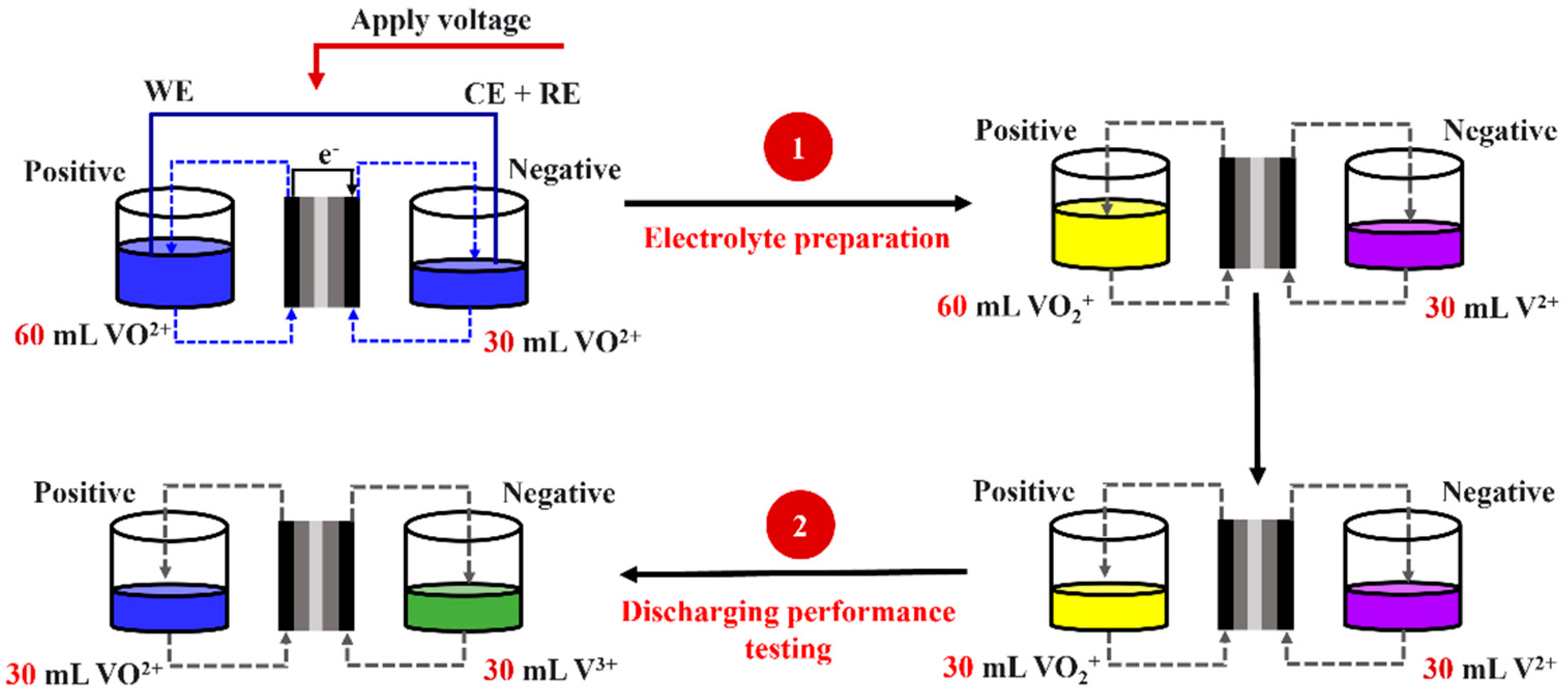
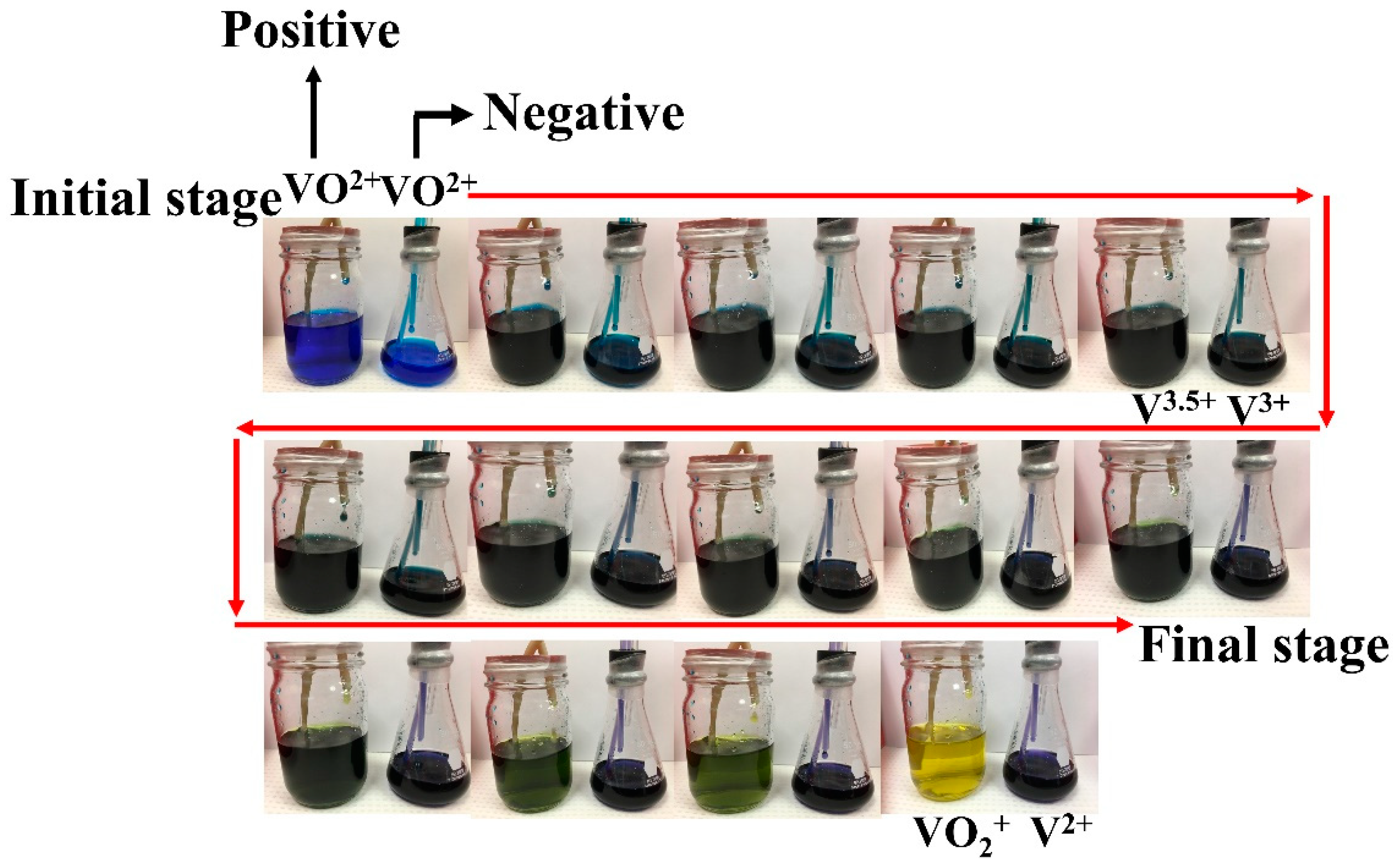





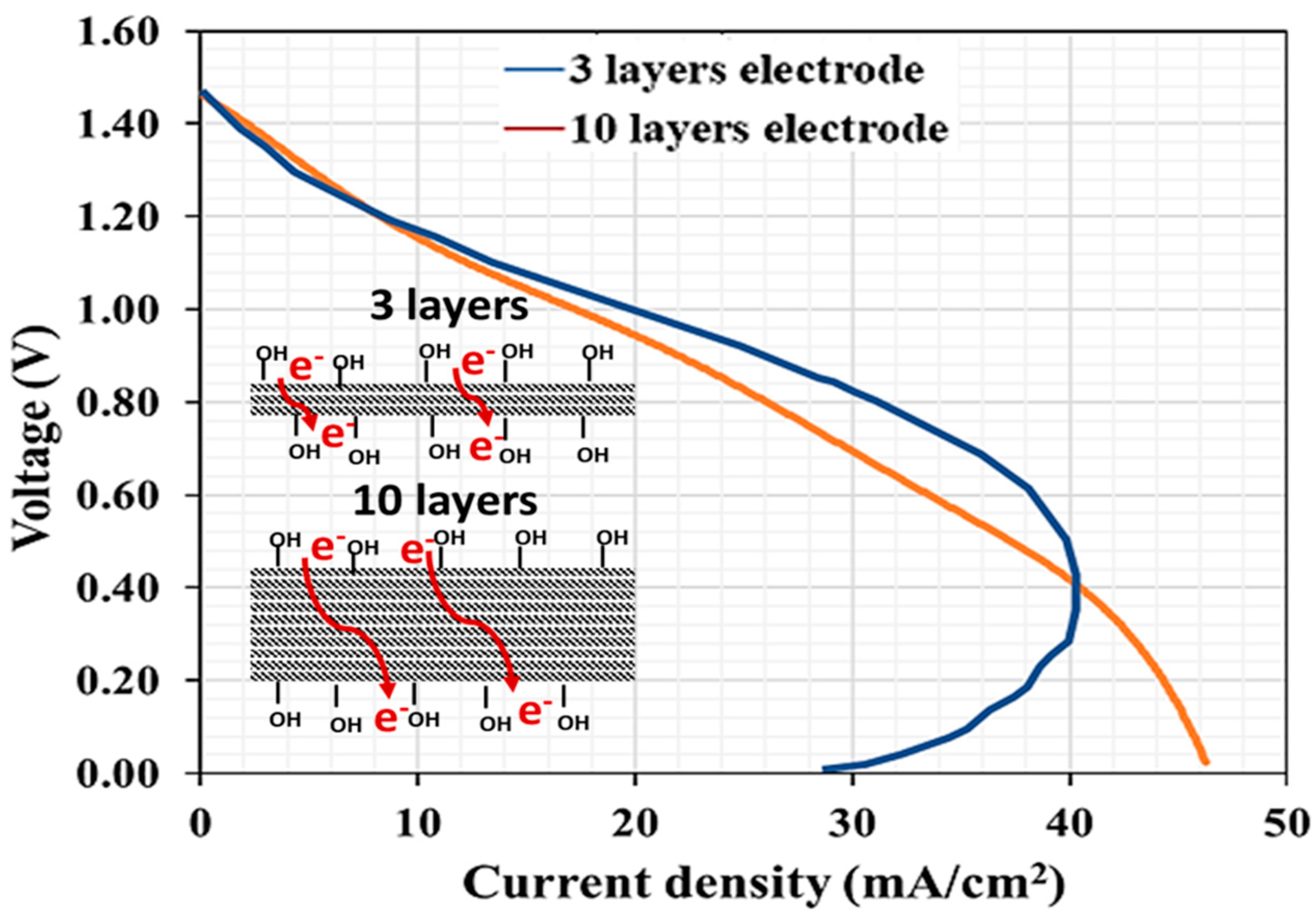
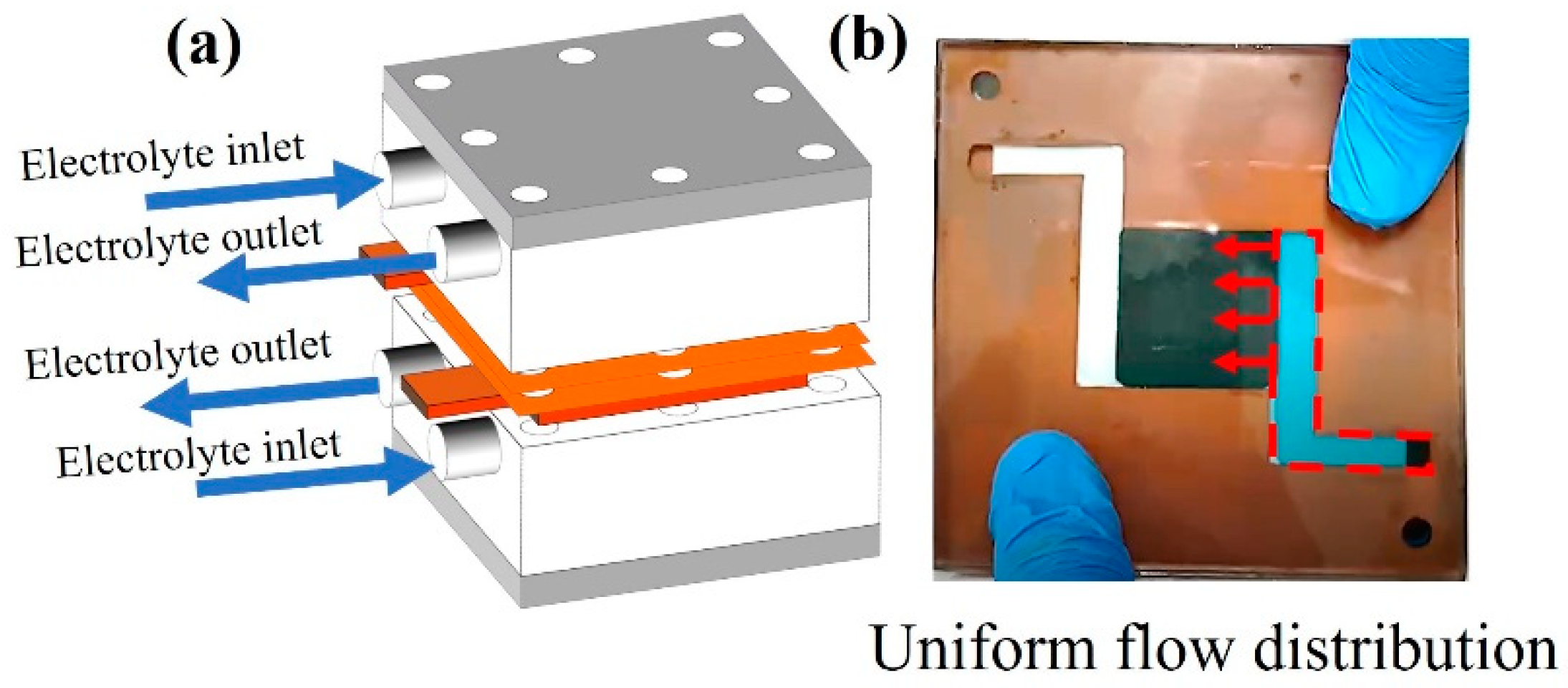

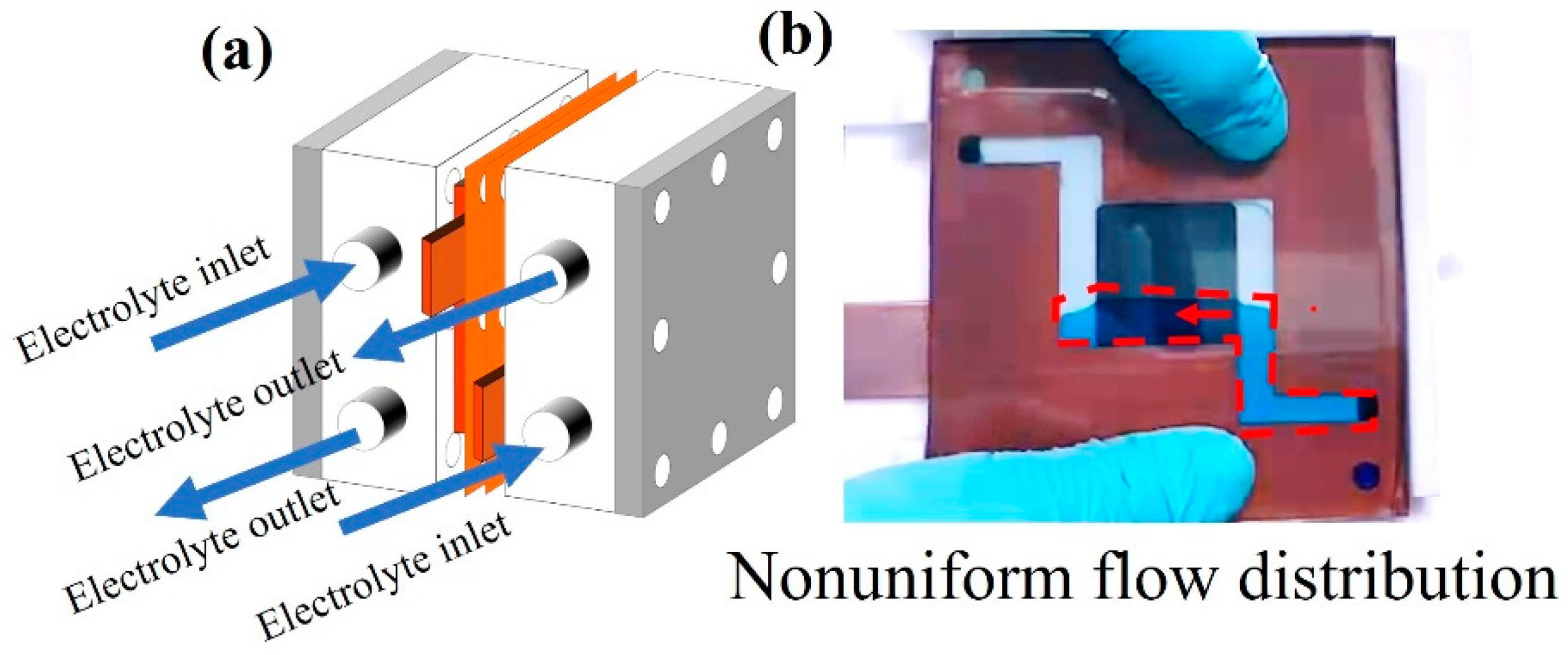
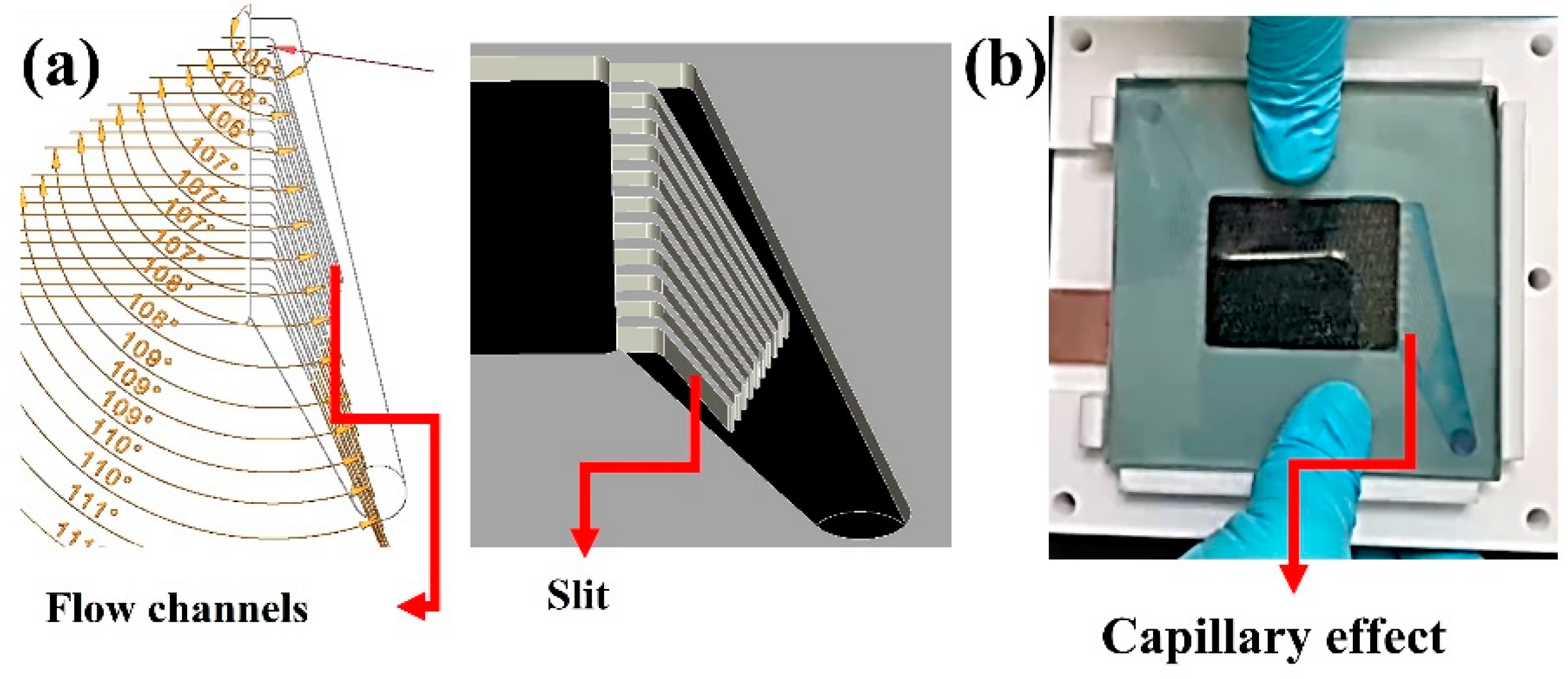
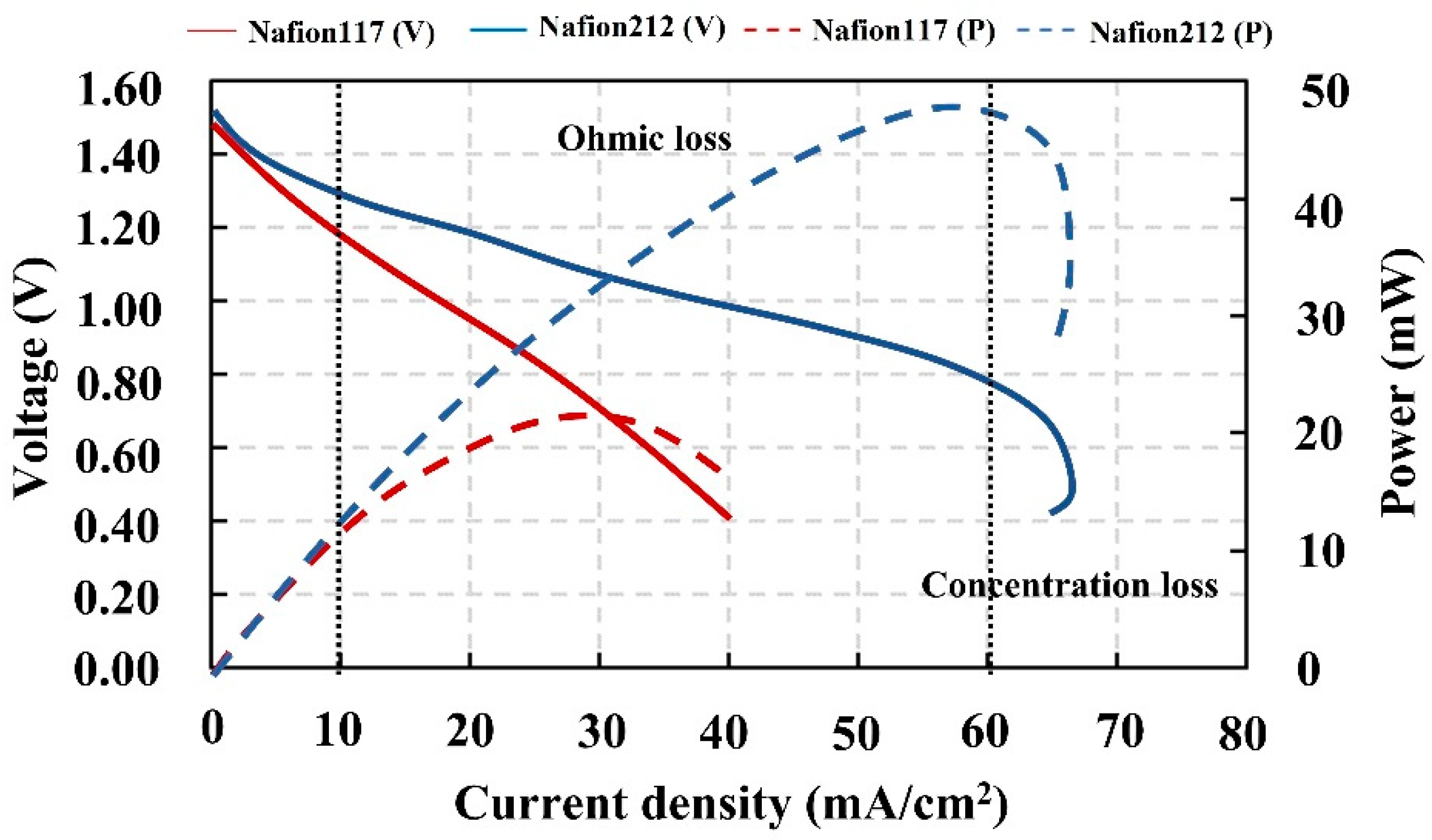
| Specifications | Values |
|---|---|
| Single-cell dimension (width × length × height) | 126 mm × 126 mm × 67 mm |
| Active area | 30 mm × 30 mm |
| Temperature range during operation | 23–30 °C |
| Voltage range | 1.2 V–1.6 V |
| Cell current density | 40–100 mA cm−2 |
| Maximum current | 4.9 A |
| Compression pressure | 87 psi (0.6 MPa), Force is recommended at 116 psi (0.8 MPa) max. |
| Applied Voltage | Maximum Power (mW) | Voltage Efficiency (%) |
|---|---|---|
| 1.6 V | 30.28 | 53.45 |
| 1.7 V | 38.46 | 50.46 |
| 1.8 V | 27.40 | 48.38 |
| 1.9 V | 30.80 | 45.64 |
| 2.0 V | 31.27 | 43.57 |
Publisher’s Note: MDPI stays neutral with regard to jurisdictional claims in published maps and institutional affiliations. |
© 2022 by the authors. Licensee MDPI, Basel, Switzerland. This article is an open access article distributed under the terms and conditions of the Creative Commons Attribution (CC BY) license (https://creativecommons.org/licenses/by/4.0/).
Share and Cite
Onyu, K.; Yeetsorn, R.; Gostick, J.; Chitvuttichot, S. Performance Analysis and Monitoring of Vanadium Redox Flow Battery via Polarization curves. Appl. Sci. 2022, 12, 11702. https://doi.org/10.3390/app122211702
Onyu K, Yeetsorn R, Gostick J, Chitvuttichot S. Performance Analysis and Monitoring of Vanadium Redox Flow Battery via Polarization curves. Applied Sciences. 2022; 12(22):11702. https://doi.org/10.3390/app122211702
Chicago/Turabian StyleOnyu, Kannika, Rungsima Yeetsorn, Jeff Gostick, and Saksitt Chitvuttichot. 2022. "Performance Analysis and Monitoring of Vanadium Redox Flow Battery via Polarization curves" Applied Sciences 12, no. 22: 11702. https://doi.org/10.3390/app122211702
APA StyleOnyu, K., Yeetsorn, R., Gostick, J., & Chitvuttichot, S. (2022). Performance Analysis and Monitoring of Vanadium Redox Flow Battery via Polarization curves. Applied Sciences, 12(22), 11702. https://doi.org/10.3390/app122211702






